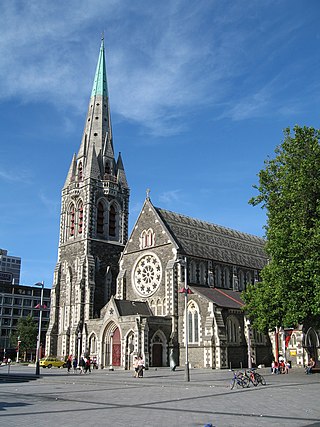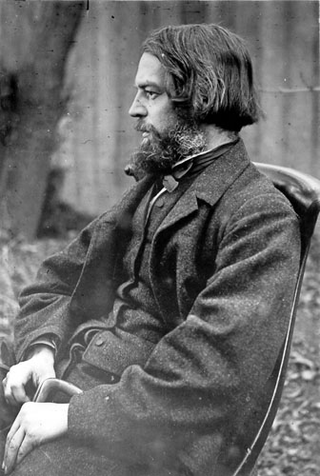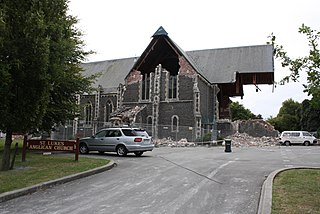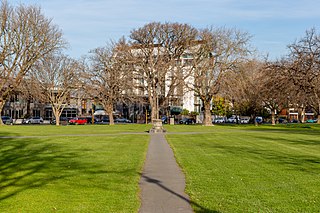
ChristChurch Cathedral, also called Christ Church Cathedral and (rarely) Cathedral Church of Christ, is a deconsecrated Anglican cathedral in the city of Christchurch, New Zealand. It was built between 1864 and 1904 in the centre of the city, surrounded by Cathedral Square. It became the cathedral seat of the Bishop of Christchurch, who is in the New Zealand tikanga of the Anglican Church in Aotearoa, New Zealand and Polynesia.

The Wellington Cathedral of St Paul, also called St Paul's Cathedral or Wellington Cathedral, is an Anglican cathedral church located on Hill Street, at its junction with Molesworth Street, in Thorndon, in the city of Wellington, New Zealand.
Cyril Julian Mountfort was a New Zealand ecclesiastical architect. He was the second son of Benjamin Mountfort.

Old St Paul's is a historic site, a city landmark and a wedding and event venue in the heart of Wellington, the capital city of New Zealand. The building served a dual role as the parish church of Thorndon and the pro-cathedral of the Diocese of Wellington of the Anglican Church between 1866 and 1964. It exemplifies 19th-century Gothic Revival architecture adapted to colonial conditions and materials, and stands at 34 Mulgrave Street, Pipitea, close to Parliament Buildings.

Benjamin Woolfield Mountfort was an English emigrant to New Zealand, where he became one of the country's most prominent 19th-century architects. He was instrumental in shaping the city of Christchurch's unique architectural identity and culture, and was appointed the first official Provincial Architect of the developing province of Canterbury. Heavily influenced by the Anglo-Catholic philosophy behind early Victorian architecture, he is credited with importing the Gothic revival style to New Zealand. His Gothic designs constructed in both wood and stone in the province are considered unique to New Zealand. Today, he is considered the founding architect of the province of Canterbury.

Glentunnel is a village located in the Selwyn District of the Canterbury region of New Zealand's South Island.

The Cathedral of the Blessed Sacrament was a Catholic cathedral located in the city centre of Christchurch, New Zealand. It was the mother church of the Roman Catholic Diocese of Christchurch and seat of the Bishop of Christchurch.

Christchurch Central City or Christchurch City Centre is the geographical centre and the heart of Christchurch, New Zealand. It is defined as the area within the Four Avenues and thus includes the densely built up central city, some less dense surrounding areas of residential, educational and industrial usage, and green space including Hagley Park, the Christchurch Botanic Gardens and the Barbadoes Street Cemetery.

Hororata is a village at the northwestern edge of the Canterbury Plains in the South Island of New Zealand. It is located 15 kilometres southwest of Darfield, five kilometres south of Glentunnel, and 50 kilometres west of Christchurch, on the banks of the Hororata River. Hororata, when translated from Maori means "drooping rata". There are a large number of rata growing in the district.

The Durham Street Methodist Church was a former heritage-listed Methodist church located in Christchurch, New Zealand. Built in 1864 in the Gothic Revival style, it was, prior to its destruction, the earliest stone church constructed in the Canterbury region.

Oxford Terrace Baptist Church is a Baptist church located in the Christchurch Central City on a prominent corner property fronting the Avon River. It is affiliated with the Baptist Churches of New Zealand.

The Church of St Michael and All Angels is an Anglican church located at 84 Oxford Terrace, Christchurch, New Zealand.

St Saviour’s at Holy Trinity is an Anglican church in Lyttelton, Christchurch, New Zealand. St Saviour's Chapel was relocated from West Lyttelton to Christchurch's Cathedral Grammar School in the 1970s. Following the earthquakes and the demolition of Holy Trinity Church, Lyttelton, St Saviour's was returned to Lyttelton to the site of Holy Trinity in 2013.

St Luke's Church was an Anglican church located in Christchurch, New Zealand. The former church was built on one of the five sites set aside in the central city in the original survey of Christchurch for the Anglican church and the building was registered as a Category II historic place with the New Zealand Historic Places Trust. Following sustained damage caused by the February 2011 Christchurch earthquake, the building was demolished in July 2011.

The Cardboard Cathedral, formally called the Transitional Cathedral, in Christchurch, New Zealand, is the transitional pro-cathedral of the Anglican Diocese of Christchurch, replacing ChristChurch Cathedral, which was significantly damaged in the 2011 Christchurch earthquake. The Cardboard Cathedral was designed by the Japanese architect Shigeru Ban and opened in August 2013. It is located on the site of the former St John the Baptist Church on the corner of Hereford and Madras Streets in Latimer Square, several blocks from the permanent location of ChristChurch Cathedral.

The Taranaki Cathedral Church of St Mary is an Anglican cathedral church, located at 37 Vivian Street, New Plymouth, in New Zealand. Following the 2011 Christchurch earthquake, in 2016 the cathedral was closed for repairs.

Latimer Square is an urban park in central Christchurch, New Zealand. It is located 400 metres (440 yd) east of the city's centre, Cathedral Square. Many commemorative events take place in Latimer Square. The square lies between the major urban thoroughfares of Gloucester Street and Worcester Street. Madras Street runs north and south to Latimer Square. The square is grassed and crossed by concrete paths and edged by mature trees. It covers an area of a little over 1.8 hectares.

St Barnabas Church is an Anglican church in Christchurch, New Zealand. It is registered as Category I by Heritage New Zealand.

St Peter's Church is an Anglican church in Riccarton, Christchurch, New Zealand. It is registered as Category II by Heritage New Zealand.






















